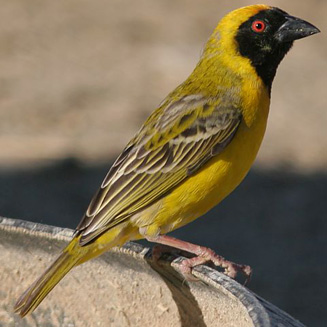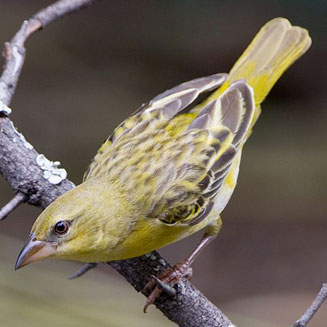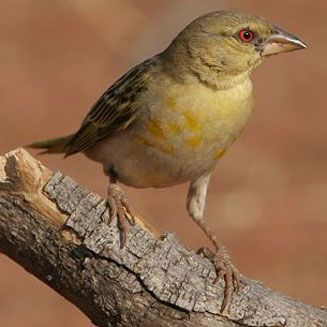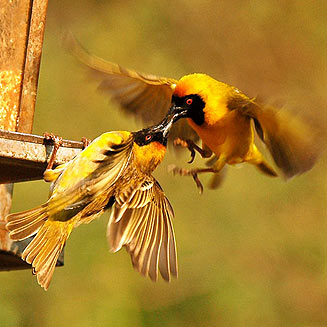|
Ploceus velatus (Southern
masked-weaver)
Swartkeelgeelvink [Afrikaans]; Ihobo-hobo (generic term for
weaver) [Xhosa]; iHlokohloko (generic term for weaver) [Zulu]; Kambara
(generic term for weaver and also applied to Yellow-crowned bishop) [Kwangali];
Letolopje, Thaha (also applied to Cape weaver) [South Sotho];
Jesa (generic name for weaver) [Shona]; Ndzheyana (generic term for weaver
or quelea) [Tsonga]; Talê, Thaga, Thaga-talê [Tswana]; Maskerwever
[Dutch]; Tisserin à tête rousse [French]; Maskenweber, Schwarzstirnweber
[German]; Tecelão-de-máscara [Portuguese]
Life
> Eukaryotes >
Opisthokonta
> Metazoa (animals) >
Bilateria >
Deuterostomia > Chordata >
Craniata > Vertebrata (vertebrates) > Gnathostomata (jawed
vertebrates) > Teleostomi (teleost fish) > Osteichthyes (bony fish) > Class:
Sarcopterygii (lobe-finned
fish) > Stegocephalia (terrestrial
vertebrates) > Tetrapoda
(four-legged vertebrates) > Reptiliomorpha > Amniota >
Reptilia (reptiles) >
Romeriida > Diapsida > Archosauromorpha > Archosauria >
Dinosauria
(dinosaurs) > Saurischia > Theropoda (bipedal predatory dinosaurs) >
Coelurosauria > Maniraptora > Aves
(birds) >
Order: Passeriformes > Family: Ploceidae
> Genus: Ploceus
 |
 |
| Southern masked-weaver male, Leeu
Gamka, South Africa. [photo Trevor Hardaker ©] |
Southern masked weaver female, Nylsvlei, South
Africa. [photo Trevor Hardaker ©] |
 |
 |
| Southern masked-weaver in
pre-breeding moult, Sericea, South Africa. [photo Trevor Hardaker ©] |
Southern masked-weaver males. [photo Callie de Wet ©] |
Distribution and habitat
Occurs across southern Africa even in arid areas, extending
into Angola, Zambia and Malawi. It generally favours semi-arid scrub, open
savanna, woodland edges, riverine thicket, farmland with scattered trees, alien
tree plantations and gardens.
|
 |
|
Distribution of Southern masked weaver in southern Africa,
based on statistical smoothing of the records from first SA Bird Atlas
Project (©
Animal Demography unit, University of
Cape Town; smoothing by Birgit Erni and Francesca Little). Colours range
from dark blue (most common) through to yellow (least common).
See here for the latest distribution
from the SABAP2. |
Predators and parasites
It (at different stages of development) has been recorded
as prey of the following animals:
Brood parasites
It has been recorded as host of the
Diderick
cuckoo.
Food
It mainly eats seeds, fruit, insects and nectar, doing most
of its foraging in small flocks, gleaning prey from leaves and branches, taking
seeds from the ground and grass stems. The following food items have been recorded
in its diet:
- Plants
- seeds
- Ulmus (elms)
- Cosmos (cosmos)
- Pinus halepensis (Aleppo pine)
- fruit
- Rhus pyroides (Common currant)
- Prunus (Satsuma plum)
- Viscum rotundifolium (mistletoe)
- Ehretia rigida (Puzzle-bush)
- flower parts
- Prunus (peaches and apricots)
- Rhigozum trichotomum (Driedoring)
- Tagetes erecta (African marigold)
- nectar
- Aloe marlothii (Mountain aloe)
- Tecoma capensis (Cape honeysuckle)
- Schotia brachypetala (Weeping boer-bean)
- Eucalyptus sideroxylon (Red ironbark)
- Hibiscus rose-sinensis (hibiscus)
- alien plants
- Grevillea robusta (Silky oak)
- Phaedranthus buccinatoius (Mexican blood trumpet)
- Insects
- Human food
Breeding
- Polygynous, as males may mate with up to about 12 females in a single
breeding season, living in colonies with 1-9 males in total, while each
female may often rear multiple broods per breeding season. It is much less
aggressive in comparison to most other weavers, although it viciously
attacks Diderick cuckoos
if they enter its territory.
- The nest (see images below) is built solely by the male, consisting of a
kidney-shaped structure with a large entrance on the bottom, made of woven
grass, palm leaves or reeds with a ceiling of leaves, such as Acacia
and Eucalyptus. If the female accepts the nest she lines the interior
with leaves, grass inflorescences and feathers. It has been recorded to
build its nest at the following sites:
- trees
- Acacia
- A. erubescens (Blue thorn)
- A. karroo (Sweet thorn)
- Combretum molle (Velvet bushwillow)
- Rhus quartiniana (Bicoloured karee)
- Phoenix reclinata (Wild date palm)
- alien plants
- Prosopis (mesquite)
- Pinus (pines)
- Eucalyptus
- Salix (willows)
- reedbeds
- barbed wire fences
- Egg-laying season is from July-March, peaking from September-February.
- It lays 1-6, usually 2-4 eggs, which are incubated solely by the female
for about 12-14 days.
- The chicks are fed by the female only on a diet of soft insect larvae
and grasshoppers, leaving the nest after about 16-17 days.
Threats
Not threatened, in fact it has adapted well to the
introduction of man-made habitats, using Eucalyptus and other alien trees
in areas which were previously barren (such as the Namib Desert).
References
-
Hockey PAR, Dean WRJ and Ryan PG 2005. Roberts
- Birds of southern Africa, VIIth ed. The Trustees of the John Voelcker
Bird Book Fund, Cape Town.
|
